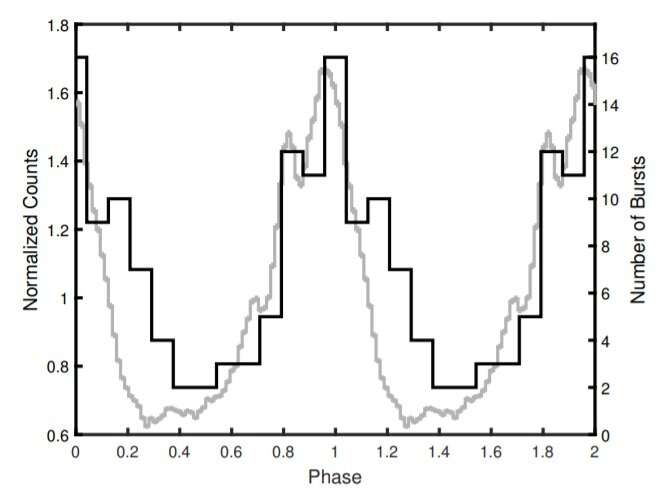Average pulse profile of SGR 1830−0645 (gray) in the energy range 0.8–7 keV, using all X-ray observations reported in the paper. The black profile represents the histogram of the bursts phase folded using the spin parameters. Credit: Younes et al., 2022.
Using the Neutron Star Interior Composition ExploreR (NICER) aboard the International Space Station, and other observing facilities, an international team of astronomers has explored a magnetar known as SGR 1830−0645. Results of the study, presented in a paper published January 14 on the arXiv pre-print server, deliver essential information regarding properties of this source.
Magnetars are neutron stars with extremely strong magnetic fields, more than quadrillion times stronger than the magnetic field of our planet. Decay of magnetic fields in magnetars powers the emission of high-energy electromagnetic radiation, for instance, in the form of X-rays or radio waves.
SGR 1830−0645 was first detected on October 10, 2020, when the Burst Alert Telescope (BAT) aboard NASA's Swift spacecraft recorded a short, soft gamma-ray burst from the direction of the galactic plane. Subsequent observations of this burst with Swift's X-ray Telescope (XRT) revealed a bright, previously unknown X-ray source, which then received designation SGR 1830−0645.
Further monitoring of this source revealed coherent pulsations with a spin period of 10.4 seconds, spin-down rate of about 0.09 pHz/s, flux decay, and also detected numerous short X-ray bursts. These results confirmed that SGR 1830−0645 is a newly found magnetar.
In order to shed more light on the properties of SGR 1830−0645, a team of astronomers led by George Younes of the George Washington University in Washington, D.C., studied this source using NICER, NASA's Chandra X-ray spacecraft and several radio facilities.
"We report on NICER X-ray monitoring of the magnetar SGR 1830−0645 covering 223 days following its October 2020 outburst, as well as Chandra and radio observations," the team wrote in the paper.
The observational campaign allowed the researchers to track the X-ray spectral and temporal evolution of SGR 1830−0645 in detail. They found that the pulse profile of this magnetar at the onset of the outburst shows a complex morphology, exhibiting three clearly distinct peaks. The observations indicate that by day 21 after the outburst, the profile simplified to a broad single peak.
The researchers found that the spin frequency of SGR 1830−0645 is approximately 0.096 Hz, while its spin-down rate was measured to be about 0.062 pHz/s. These results suggest that the magnetar has a dipole field strength at the equator at a level of 270 trillion G, a spin-down age of some 24,400 years, and a spin-down luminosity of 0.24 decillion erg/s.
The monitoring of SGR 1830−0645 also revealed 84 typical short magnetar bursts with an average duration of about 30 milliseconds. They tend to occur close to the surface emission pulse maximum, what, according to the authors of the paper, points out to a very low altitude for the burst emission region, and a triggering mechanism connected to the surface active zone.
More information: G. Younes et al, X-ray burst and persistent emission properties of the magnetar SGR 1830-0645 in outburst. arXiv:2201.05504v1 [astro-ph.HE], arxiv.org/abs/2201.05504
© 2022 Science X Network
























